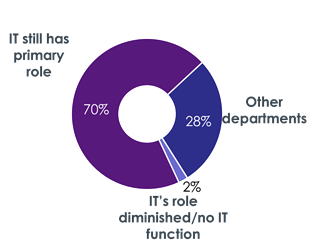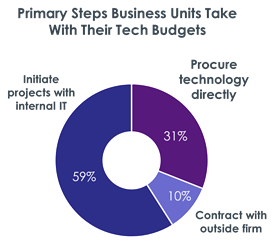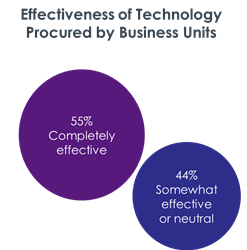As you may be aware, Channel Dynamics has been assisting the US based Industry Trade Association organisation CompTIA to establish a local ANZ channel community. While CompTIA is best known for its training and education, it also conducts primary research. Today we drill down into the findings from a recent CompTIA survey to understand more about changing customer purchasing habits, and how this can impact your sales strategy and how you sell to customers.
Please note that the focus of this article is around mid to larger size organisations that generally have an IT department (i.e. greater than 100 but less than 1,000 employees). SMBs (ie. companies of less than 100 employees) generally view and purchase IT differently and are excluded
from this article, but will be covered in the near future.
Traditional IT versus Cloud
On premise IT (both hardware and software) is still being bought by medium to large organisations, but increasingly some form of Cloud delivered IT is fast becoming a mainstream choice.
With this shift to the Cloud, it is not only the technology delivery method that is changing, but also the way these IT purchases are approved and paid for. As a result, there are now far more conversations by the customer purchasing decision makers around expense based OpEx IT budgets rather than traditional CapEx budgets (which would have been about whether to purchase, own and depreciate). Therefore, as we have been advocating for some time now, the astute channel sales person has needed to rapidly come up to speed with a new set of skills, primarily financial, in order to have the appropriate conversations with customers.
However, is this enough? The CompTIA research suggests that not only is a different set of selling skills required, but also completely different account engagement is required in order to obtain the IT infrastructure or equipment purchasing decision.
The Rise Of The Business Unit
As we know, the shift to Cloud computing and OpEx vs CapEx spending has been a huge deal for the channel. What is also now becoming a huge deal for the channel is the shift on who is purchasing or influencing the approval of the IT spend. Increasingly, IT spend and direction is being determined less by the IT department, and more by the business units.

Source: CompTIA’s Building Digital Organizations study | Base: 375 U.S. IT professionals / 275 U.S. business professionals
Bottom line, if you are still selling exclusively to the IT department then you may be only selling to 70% of the decision makers.
The CompTIA research identified departments outside of IT as also having critical roles in IT purchasing decisions. Non IT departments and the percentage of involvement in the IT purchasing decision are outlined below. Note that often multiple departments can be involved, so the total does not equal a neat 100%:
• 59% Finance
• 47% Marketing
• 45% Sales
• 45% HR
Source: CompTIA’s Building Digital Organizations study | Base: 375 U.S. IT professionals / 275 U.S. business professionals
So if business units are now having a significant influence on the direction or outcome of IT spend, where or how do they obtain their information? In short, many sources, including the incumbent supplier.

Source: CompTIA’s Building Digital Organizations study | Base: 375 U.S. IT professionals / 275 U.S. business professionals
In conjunction with this information on business unit influence, it is critical for the channel sales professional to understand how the individuals within the business units obtain their information. The message is do not ignore the influence of the IT department, but there are plenty of other sources the business units look to. Their sources of information are outlined below:
• 53% Personal research
• 51% Internal IT department
• 47% Business events
• 41% Tech events
• 38% Peers
• 34% Third party firms
Source: CompTIA’s Building Digital Organizations study | Base: 375 U.S. IT professionals / 275 U.S. business professionals
Rogue IT, Friend or Foe?
There has been quite a lot of discussion about cloud computing and how it has led to the emergence of “rogue IT” or “shadow IT” and the CompTIA research shows that this is a real phenomenon.
Therefore, the next piece in the puzzle of understanding the impact of the business unit is gaining some insight on their influence on the IT spend and procurement of IT. Consistent with the earlier findings, 31% of the business units will procure technology directly i.e. not via the IT department. 10% will even contract directly. This means that again the message for the channel is to engage with the client beyond the IT department.

But is rogue or shadow IT really the end of the world, or just the reality of how business now goes about evaluating and purchasing IT? The research indicates that most of the business unit IT purchases perform at around a similar level of effectiveness or internal satisfaction as the IT department decisions, so this trend is unlikely to change immediately.

Source: CompTIA’s Building Digital Organizations study | Base: 375 U.S. IT professionals / 275 U.S. business professionals
Conclusion and Tips
There has been plenty written about the rise of cloud computing and the benefits that it can deliver to the business user, so let us assume this is not going to change. Additionally in previous articles we have touched on the need for a different set of partner selling skills and account engagement that annuity billing requires compared to perpetual or one off selling. This data now suggests that not only does the channel need to adapt what and how they sell, they also need to change who they sell to if they are going to make their transition to a cloud or services dominated business model.
The IT channel is often very focused on the technology itself, whereas the business unit decision makers are less focused on the technology, and more on the business benefit the technology will deliver for them i.e. the outcome.
This business unit era of IT purchasing requires a team effort of business savvy channel sales professionals. It also requires IT centric sales engineers or solution architects to engage with the client right across the organisation. Together they need to cover both the IT or technology implications and benefits, as well as the business drivers and business benefits of the proposed solution. Some of the more important points and tips we suggest the channel take away from this research include:
-
- IT budgets and projects are no longer the exclusive domain of the IT department.
- Engaging with the IT department is still important, but they may also “sell” internally to the business units, so ensure the message to them is not just IT, but also business orientated.
- Make sure that business and financial skills knowledge is up to the level required.
- Develop a broader account engagement and development plan to include all of the other significant departments such as Finance, Marketing and HR.
- Ensure that the messaging and marketing to these departments is not in “IT speak” but rather stresses the business outcome and business value that you and your company can provide.


